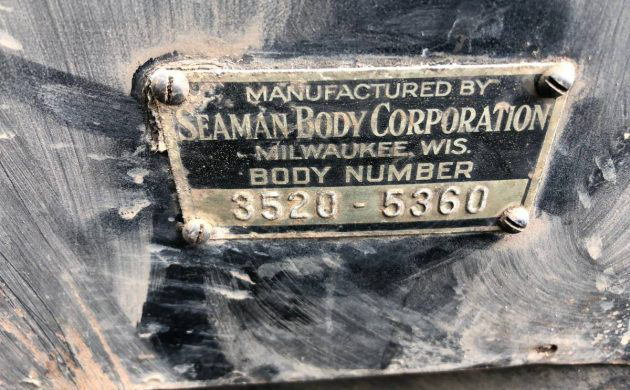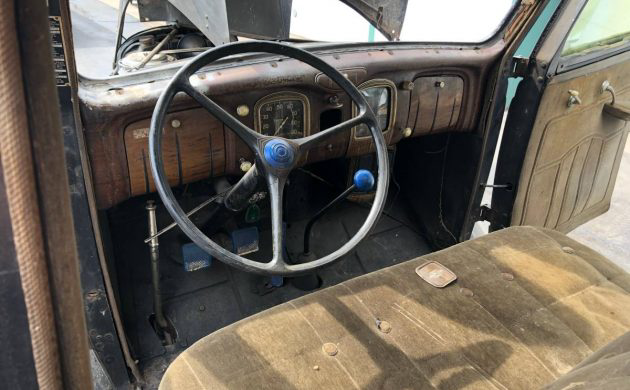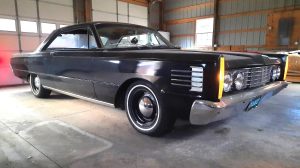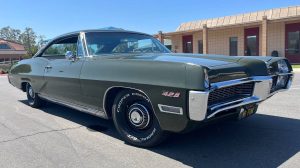You might be a bit confused if you click through to the craigslist ad for this barn find Nash, as it lists the car as a 1934 “Big Six.” I was a little disappointed myself when I realized the seller’s mistake—I had done all this research and had all these facts to share about the 1934 Nashes!—but I guess it’s fair to expect that when you’ve parked a car for 55 years, as the family selling this car has done, you’re liable to forget a detail or two. In any event, my research eventually set me straight that this is a 1935, not a ’34; we’ll take the seller’s word for it that the car is in Duluth, Minnesota, and that the asking price for this long-stored Nash is $4,500.
The proof: the body plate identifying this car as a 1935 Series 3520 “Advanced Six,” as opposed to the 1934 Series 1220 “Big Six.” My research wasn’t entirely in vain anyway, as the story of Nash in 1935 is of course a continuation of the story of Nash in 1934 and 1933. Hit hard, like all other automakers, by the Great Depression, Nash lost money for the first time in 1933, causing the small company to postpone a planned all-new car from 1934 to ’35. In the meantime, Count Alexis de Sakhnoffsky was brought in to give the otherwise carryover ’34s some Art Deco flair; Sakhnoffsky, an illustrator with a distinctive, stylized sensibility, so frustrated Nash’s body engineers with his loose sketches that they designed the 1935-38 cars themselves, not trusting another stylist until Don Mortrude was hired to design the 1939 Nash.
The ’35 Nash may not have been designed by professional stylists, but it was nevertheless a very handsome, up-to-the-minute car, and boasted important firsts for Nash including hydraulic brakes and an all-steel body. Sales improved considerably—44,637 Nashes and Lafayettes for the year, compared to 28,664 in 1934—and the new car put Nash back on the road to profitability by 1936.
That all-steel construction seems to have held up quite well on this 34,213-mile example, which has been parked in (presumably very dry, well-insulated) indoor storage since 1963. The fenders show evidence of some low-speed run-ins, but there’s no apparent rust and the trim appears very complete. The cloth roof covering—remember, “all-steel construction” in the ’30s referred to the framing, and it would be 1936 before GM’s “turret top” brought single-piece stamped steel roofs into the mainstream—is intact and in good shape.
The 235 cubic inch OHV inline six of this mid-level Nash was a carryover from 1934, rated at 88 horsepower and 100 lb.-ft. of torque. A three-speed manual sends that power to the rear wheels; this car is not claimed to run, but the engine compartment is simplicity itself—everything certainly seems to be intact.
Same for the interior, although a few of the pieces aren’t exactly attached to the car anymore. The fabric upholstery has held up remarkably well, all things considered, but it would probably best serve as a pattern for replacements at this point, especially at the front.
This is a project car, to be sure, but a neat survivor of a slightly-left-of-mainstream American classic that doesn’t deserve to be forgotten. This car, at a list price of $945 in 1935 and apparently lacking many, if any options (which could include a sidemount spare tire, a clock, a radio, a heater, a cigar lighter, and fender skirts) and built by a company suffering in a very rough economy, still boasts important technological advances and beautiful streamlined style. Do you think it’s worth reviving?
















In my minds eye I can envision this car when it was new. It must have been a looker the lines just flow from front to back, and I’ve always thought that the suicide rear doors added an element of cool to any of these 30’s cars. I think it would be a great DIY project for someone with some skills and tools I hope it lands in the hands of just such a person.
If you like suicide doors try a 4-door Rolls-Royce Cullinan, Phantom or Ghost. The only difference is they are refereed to as “carriage doors” not that unspeakable “suicide door”.
An excellent write-up. Great job, Nathan.
Beautiful car, a real work of art. I would like to do a full cosmetic restoration and upgrade the brakes and driveline so I could use it as my daily driver.
And to think, flow through ventilation, a precursor to A/C.
No windshield allows cool air to flow through your hair. Absolutely wonderful, no rain falls on your head and cool breezes flow through your hair.
As a daily driver, wouldn’t that turn heads???
What a handsome and rare car. Much more interesting due to its rarity than the Fords and Chevys of the same year. I would just clean it up, replace the brakes and tires, and drive it like it is…the barn find look is way cool these days.
Lengthen the body through the doors and widen the body to sit it on an Escalade AWD chassis and full drive train . and No patina rather deep emerald green .
It’s probably just easier to put it on a late model Jeep Cherokee frame and make into a mud bogger. If you are going to ruin it, you might as well make it into something you would have the most fun with.
Steve R
Green? Yes. All else, no. IMHO
Nice to see it still has its original Armstrong starter.
Styling is very reminiscent of Huppmobiles of the same period with the exception of Hupp’s wonderful molded-in headlight treatment…
Nice research by writer.
Definitly worth a resto.
Nice.Great info and a beautiful car.
And people wigged out when Saturn put the instruments in the middle of the dash on the ION.
Quite a common position for them long ago.
And no one went crazy.
Lots of cars in the 30s had instruments in the middle or interchangeable instrument clusters and glove boxes. This was so that the steering wheel could be put on either the right or the left. Then in the 50s, the US industry largely gave up on the export market.
I’m intrigued by the cable and pulley system from the firewall to the carb. It must be the throttle linkage. It also looks like the generator has a shaft out the back to drive something else.
@Bellingham Fred, the generator ties into the water pump.
That is a nice pulley system for the throttle; a similar setup was on my ’32 for the starter. It attached to a lever switch on the starter and engaged when you pulled the knob.
I love the body style! This will look nice when redone!
I have this same car sitting in my shop right now. Have owned this car since 1974. Currently getting a new drive train. Mustang II front, power steering, disc brakes, (9″ Ford rear end and coil over springs). Power by a 1965 Cadillac 429 with a 700r4 transmission. Would post pictures if I knew how. Lyle